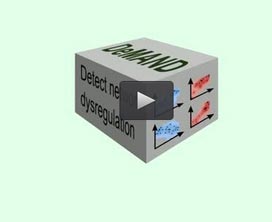

By analyzing drug-induced changes in disease-specific patterns of gene expression, a new algorithm called DeMAND identifies the genes involved in implementing a drug's effects. The method could help predict undesirable off-target interactions, suggest ways of regulating a drug's activity, and identify novel therapeutic uses for FDA-approved drugs, three critical challenges in drug development. GIF version here: http://newsroom.cumc.columbia.edu/?p=34484
Credit: Califano lab/Columbia University Medical Center
“For the first time we can perform a genome-wide search to identify the entire set of proteins that play a role in a drug's activity,” says study co-author Dr. Andrea Califano, the Clyde and Helen Wu Professor of Chemical Systems Biology and chair of the department of Systems Biology at CUMC.
Scientists design drugs to pinpoint molecular targets in the cell. However, when a drug enters the human body, it becomes part of an incredibly complex system, and can interact with other molecules in ways that are hard to predict. This unanticipated cross-talk causes side effects and stops many promising drug candidates from being used in clinical care. Unfortunately, current experimental methods don't allow scientists to identify the full repertoire of proteins that are affected by a drug.
Members of Dr. Califano's lab have devised a new approach called DeMAND.
(Detecting Mechanism of Action by Network Dysregulation) to characterize a drug's effects more precisely. The method involves creating a computational model of the network of protein interactions that occur in a diseased cell. Experiments are then performed to track gene expression changes in diseased cells as they are exposed to a drug of interest. The DeMAND algorithm combines data from the model with data from the experiments to identify the complement of proteins most affected by the drug.
DeMAND improves on more labor intensive and less efficient methods, which are only capable of identifying targets to which a compound binds most strongly. This provides a more comprehensive picture, because DeMAND identifies many molecules that are affected in addition to the drug's direct target.
So far, DeMAND's predictions are proving to be accurate when tested with follow-up experiments. The researchers report that when they exposed human diffuse B-cell lymphoma cells to a panel of drugs, the algorithm identified 70% of previously documented targets. “The accuracy of the method has been the most surprising result,” says Dr. Califano.
The algorithm makes it possible to identify a variety of compounds that cause similar pharmacological outcomes. Using DeMAND, the researchers showed that a similar subset of proteins is affected by the unrelated drugs sulfasalazine and altretamine. Altretamine is currently used to treat ovarian cancer, but these results suggest that, like sulfasalazine, it could be used for bowel inflammation or rheumatoid arthritis too.
Co-senior author Mukesh Bansal sees great potential in this approach, saying, “DeMAND could accelerate the drug discovery process and reduce the cost of drug development by unraveling how new compounds work in the body. Our findings on altretamine also show that it can determine novel therapeutic applications for existing FDA-approved drugs.”
###
The Cell paper is titled, “Elucidating Compound Mechanism of Action by Network Perturbation Analysis.” The list of authors is: Andrea Califano, Jung Hoon Woo, Yishai Shimoni, Wan Seok Yang, Prem Subramaniam, Archana Iyer, Paola Nicoletti, María Rodríguez Martínez, Gonzalo López, Ronald Realubit, Charles Karan, Brent R. Stockwell, Mukesh Bansal (all at CUMC), and Michela Mattioli, (Fondazione Istituto Italiano di Tecnologia).
This work was supported by grants from the National Institutes of Health (5U01CA168426, 1U01CA164184-02, 3U01HL111566-02, 5U54CA121852-08, 5R01CA097061, R01CA161061), New York Stem Cell Science (C026715) and the Howard Hughes Medical Institute.
The authors declare no financial or other conflicts of interest.
Columbia University Medical Center provides international leadership in basic, preclinical, and clinical research; medical and health sciences education; and patient care. The medical center trains future leaders and includes the dedicated work of many physicians, scientists, public health professionals, dentists, and nurses at the College of Physicians and Surgeons, the Mailman School of Public Health, the College of Dental Medicine, the School of Nursing, the biomedical departments of the Graduate School of Arts and Sciences, and allied research centers and institutions. Columbia University Medical Center is home to the largest medical research enterprise in New York City and State and one of the largest faculty medical practices in the Northeast.
For more information, visit cumc.columbia.edu or columbiadoctors.org.












